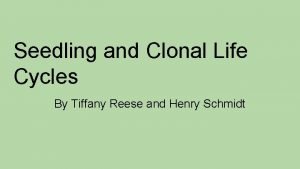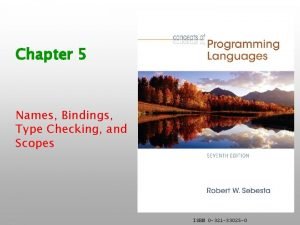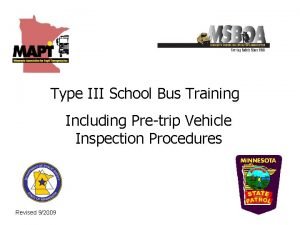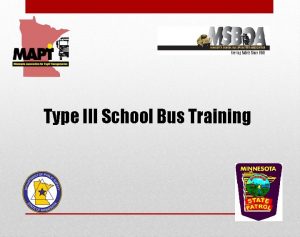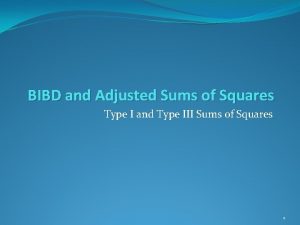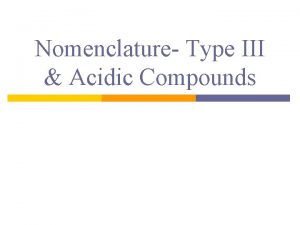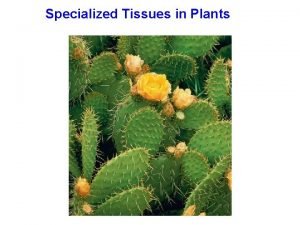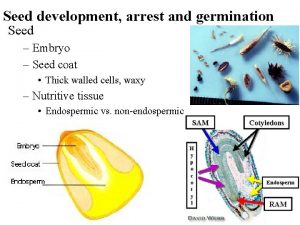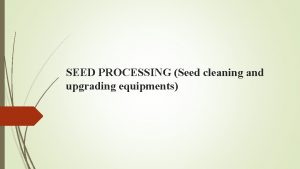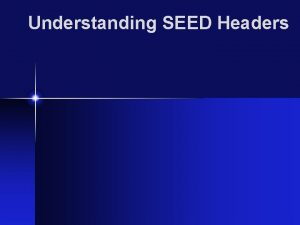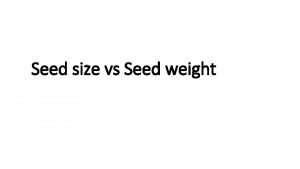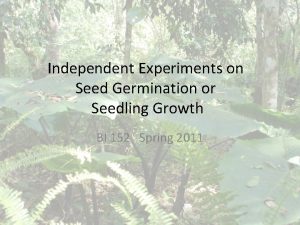Chapter III Seed and Seedling Structure and Type











- Slides: 11

Chapter III Seed and Seedling – Structure and Type I. Organ: A part of a plant, which is composed of multiple tissues, has significant morphological characteristics and specific functions in appearance and can be easily distinguished. II. Structure of Seed (I) Embryo: It is the most important part of a seed, and a rudiment of a new plant. Radicle: It is conical. Embryonic cells constitute growing points. Plumule: It is in a form of young leaf. Likewise, its growing points are also constituted by embryonic cells. Embryo axis: Between radicle and plumule. Epicotyl: A section from cotyledon attachment region to the first true leaf. Hypocotyl: A section from cotyledon attachment region to radicle. Cotyledon: The earliest leaf of a plant - dicotyledon and monocotyledon.

Chapter III Seed and Seedling – Structure and Type

Chapter III Seed and Seedling – Structure and Type Seed coat Endosperm Cot yled on Embryo Plumule Embryo axis Radicle

Chapter III Seed and Seedling – Structure and Type (II) Endosperm 1. Concept: It is a place where the seed stores nutriment in a centralize way. It is succulent in general and mainly composed of saccharide, lipid and protein, as well as a little amount of inorganic salts and vitamins 2. Perisperm: In the process of formation of a seed, the nucellus of ovule is not completely absorbed to disappear. Instead, a part is left over and forms perisperm.

Chapter III Seed and Seedling – Structure and Type Triticum vulgare (Poaceae), longitudinal section of caryopsis, with detail of aleurone layer (inset). al=aleurone layer, cp=coleoptile, cr=coleorhiza, end=endosperm, ep=epiblast, fl=foliage leaves, ra=radicle, sa=shoot apex, sc=scutellum. Scale=1 mm.

Chapter III Seed and Seedling – Structure and Type Percentage composition of main nutrient components in the seeds of a few varieties of plants Plant variety Starch Protein Fat Corn (Zea mays) 75 12 9 Wheat (Triticum aestivum) 75 12 2 Barley (Hordeum vulgare) 76 12 3 Pea (Pisum sativum) 56 24 6 Soybean (Glycine max) 26 37 17 Peanut (Arachis hypogaea) 12 31 48 Rape (Brassica napus) 19 21 48

Chapter III Seed and Seedling – Structure and Type (III) Seed coat: It is a covering part outside a seed and often consists of a few layers. Some seed coats are in a shape of thin film or paper and some are hard and thick. Seed coat has an effect of protecting the seed from mechanical injury of external force and preventing intrusion of pests and diseases. Hilum: The mark left when a seed falls from the fruit, i. e. : the location where the seed is disengaged from funicle. Seed hole: It is a mark left at the micropyle of ovule. Caruncle: Spongy bulge generated from extension of seed coat. Raphe: As for a seed formed from inversely generated ovule, the central location of its segmental venter has a longitudinal mark that rises slightly. It is a location where vascular bundles are distributed in a centralized way, and is called raphe.

Chapter III Seed and Seedling – Structure and Type III. Seed Types 1. Albuminous seed: consist of three parts: seed coat, embryo and endosperm. 2. Exalbuminous seed: consist of two parts: seed coat and embryo and no endosperm. In the early stage of seed formation, nutriment is absorbed by embryo and transferred to cotyledon and stored.

Chapter III Seed and Seedling – Structure and Type IV. Seedling Types 1. Epigaeous seedling: Hypocotyl grows in an accelerated way and pushes both cotyledon and plumule out of earth. This way of germination is called epigeal germination. (Soybean, cotton, castor and onion) 2. Hypogaeous seedling: Epicotyl is extended. Cotyledon or endosperm is left in earth. (Vicia faba, wheat and paddy)

Chapter III Seed and Seedling – Structure and Type Growth and development of a common bean plant.

Chapter III Seed and Seedling – Structure and Type Growth and development of corn.

